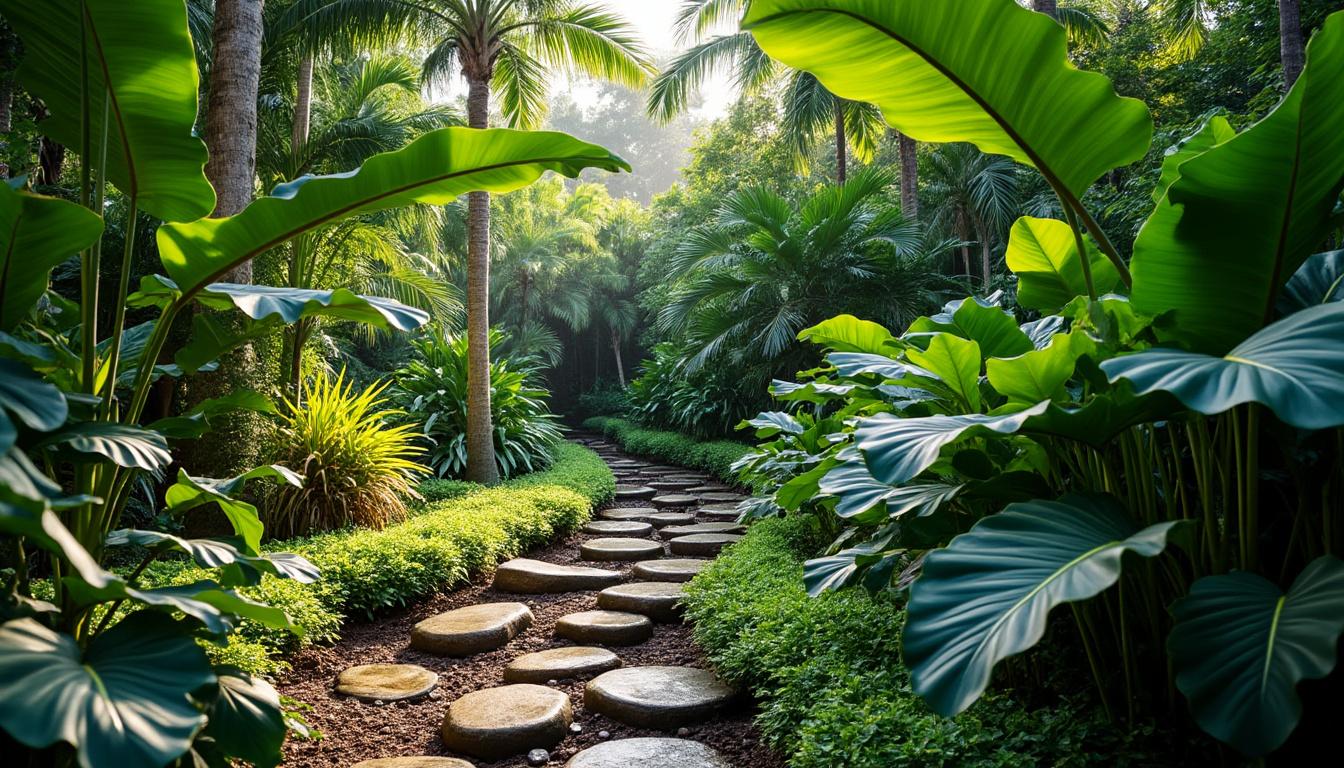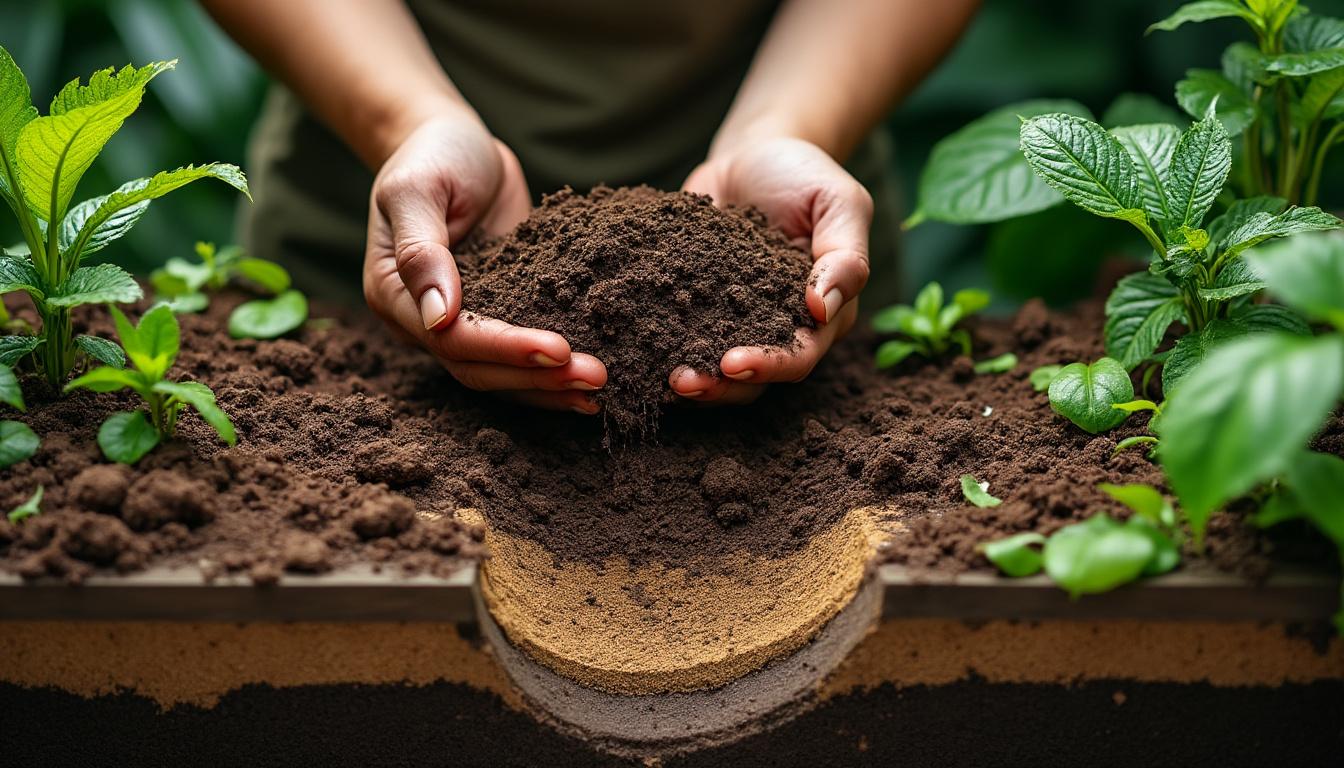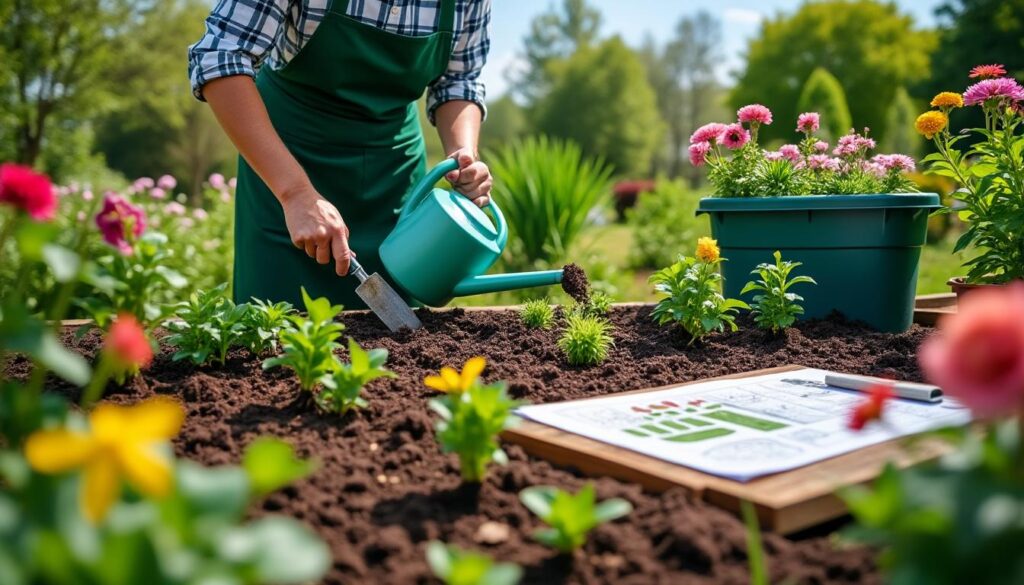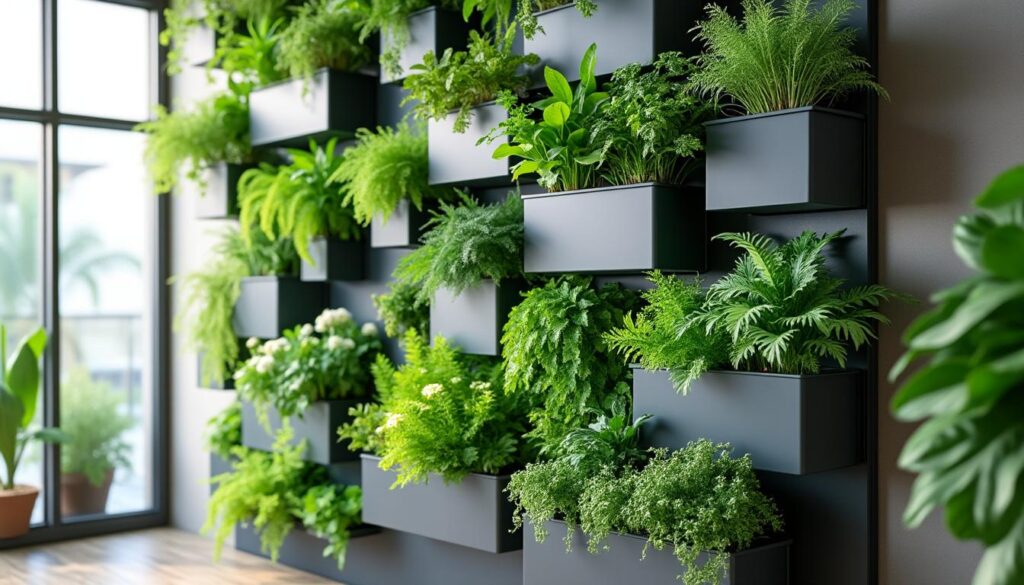Choosing ideal plants for tropical gardens depends greatly on the local climate, available light, and how water behaves in your soil. The good news: with the right selection and some simple care, your garden can be lush all year round.
| Short on time? Here’s the essential: |
|---|
| ✅ Prioritize climatic adaptation by region (equatorial, coastal, subtropical, altitude) to reduce losses and maintenance 🌦️ |
| ✅ Organize the garden by light zones: full sun, partial shade, and shade, and regulate humidity 💧 |
| ✅ Avoid waterlogged soil: use efficient drainage and organic cover for healthy roots 🪴 |
| ✅ Combine structural species (palms) with foliage (calatheas) and impactful flowers (heliconias, hibiscus) for tropical layers 🌺🌿 |
Ideal plants for tropical gardens by region: combine climate and selection wisely
The starting point is understanding how the climate shapes plant behavior. In equatorial areas, consistent moisture favors heat-loving foliage and abundant watering. In areas with a marked dry season, the roots need rich but light soil that doesn’t retain water. In coastal regions, salty winds require tolerant species; in altitudes and subtropical zones, occasional cold demands protection and more robust choices.
To illustrate, think of three real profiles. In Manaus, an open backyard can host heliconias, ornamental banana trees, and bromeliads, which love heat and high humidity. In Salvador, the sea breeze calls for resilient palms, hibiscus in full sun, and scheffleras as natural windbreaks. Meanwhile, in Curitiba, with humid summers and cold winters, the design works better with bird-of-paradise, anthuriums, and ferns in protected areas, along with calatheas under filtered shade.
If your garden is in the Azores or Madeira (mild and humid climate), the tropical green mass thrives with little intervention, as long as the wind is tamed with living fences. In drier interior zones, the solution is well-regulated irrigation and the use of mulching, which keeps the soil cool and enriches the microbiota.
- 🌧️ Equatorial and very humid: heliconia, ornamental banana, bromeliad, young palms under controlled watering.
- 🌬️ Windy coastal: hibiscus, salt-tolerant palms, schefflera, bird-of-paradise in groups.
- 🌤️ Tropical with dry season: versatile bromeliads, structural agave, resilient hibiscus, monstera (devil’s backbone) in partial shade.
- ❄️ Subtropical/altitude: protected anthuriums and ferns, calatheas in shade, strelitzia with gentle sun.
- 🏝️ Islands with mild climate: lush combination with attention to wind and water drainage.
A conscious choice reduces future costs. By aligning species and region, you lower the risks of pests and avoid excessive efforts with watering and fertilization. Selection hits the mark when the garden seems to “run on its own”.
| Region/Condition 🌎 | Key Species 🌿 | Essential Care ⚙️ |
|---|---|---|
| Humid equatorial | Heliconia, Ornamental Banana, Bromeliad | Frequent watering, fertile and drained soil, wind protection for broad leaves |
| Windy coastal | Hibiscus, Palms, Schefflera | Living windbreaks, organic compost, regular watering without waterlogging |
| Tropical with dry season | Agave, Bromeliads, Devil’s Backbone | Thick mulching, adjusted watering, partial shade for sensitive foliage |
| Subtropical/Altitude | Anthurium, Fern, Strelitzia | Cold protection, filtered light, rich in organic matter |
| Mild islands | Palms, Bromeliads, Hibiscus | Wind control, precise drainage, formation pruning 🌱 |
Practical summary: choose species that “talk” to the local climate. This way, your tropical garden gains vigor and longevity without unnecessary effort.

With the region defined, the next step is to position each plant based on light: full sun, partial shade, or shade. That is where the composition gains balance.
Sun, partial shade, and shade: position each plant for a healthy tropical garden
Light defines success. Full sun species require direct radiation and ventilation, while partial shade foliage likes diffuse brightness. There are also shade plants that prefer protected environments, with humidity in the air and little wind. By respecting these groups, the garden becomes denser, more colorful, and resilient.
In full sun, hibiscus bloom continuously and bird-of-paradise showcases intense colors. Agaves serve as visual anchors, providing architecture and low care, as long as the soil drains well. For partial shade, anthuriums and devil’s backbone (Monstera) deliver volume and elegance; watering should be regular, without waterlogging. In bright shade, ferns and calatheas appreciate humid air and leaves free from direct sun, keeping vibrant green.
Some species transition between zones. Bromeliads adapt from sun to partial shade, just avoid excess standing water in the cup. Schefflera withstands sun and partial shade, excellent for forming green mass. Orchids require filtered light and protection from wind gusts; they bloom better when attached to trunks or airy pots. Ornamental banana trees and heliconias prefer intense light with high humidity, reminiscent of tropical clearings.
- 🌞 Full sun: hibiscus, bird-of-paradise, agave, well-watered young palms.
- 🌤️ Partial shade: anthurium, devil’s backbone, bromeliads, schefflera.
- 🌑 Bright shade: fern, calatheas, protected orchids.
- 💨 Windy areas: avoid wide leaves without windbreak; include schefflera or living fences.
- 💧 Dry environments: intensify foliar sprays on ferns and calatheas.
| Species 🌺 | Recommended Light ☀️ | Water and Observations 💧 |
|---|---|---|
| Hibiscus | Full sun | Moist and well-drained soil; large and constant flowers |
| Bird-of-paradise | Sun to partial shade | Regular watering; fertile and airy soil |
| Agave | Full sun | Little watering; prioritize drainage and organic matter |
| Anthurium | Partial shade | High humidity; avoid direct sun on leaves |
| Bromeliads | Versatile (sun to partial shade) | Avoid excess standing water in the cup; good ventilation |
| Fern | Bright shade | Frequent watering and spraying; no wind |
| Orchids | Filtered light | Wind protection; airy pots or trunks |
Mapping the light in your space before planting avoids future swaps and accelerates the “closure” of the garden, creating stable microclimates.
With the light resolved, it’s time to prepare the right soil to keep the roots active and healthy all year round.
Soil and drainage in the tropical garden: nutrients, moisture, and always active roots
Tropical plants prefer fertile, lively soil with efficient drainage. The right combination is abundant organic matter, correct granulation, and ground cover. In pots, mixtures with coconut fiber, pine bark, coarse sand, and compost ensure porosity. In the garden, a base of organic compost, humus, and a good percentage of aggregates (washed sand, fine gravel) prevents compaction and waterlogging.
For very wet areas, French drains (channels with gravel and geotextile) solve persistent puddles. In poor soils, continued organic fertilization — compost, bokashi, or well-composted manure — creates a “buffet” for microbiota and roots. Some species respond well to foliar nitrogen, such as ferns, but avoid excess. The secret is light consistency, not fertilization spikes.
Watering needs to follow the climate. In hot summers, frequent watering at dawn keeps humidity without thermal shocks; during rainy periods, reduce volume to avoid fungi. Covering with dry leaves, bark, and clippings (mulch) reduces evaporation, feeds the soil, and prevents competitive weeds. This layer also stabilizes the temperature in surface roots, common in bromeliads and devil’s backbone.
- 🧪 Base mix for pots: 40% compost, 30% fiber/bark, 20% coarse sand, 10% perlite or fine gravel.
- 🪨 For beds: add 5–10 cm of organic matter per cycle and renew mulching every 3–4 months.
- 🚿 Watering: little and frequent for shade foliage; deep and spaced for sun species like agaves.
- 🍃 Fertilization: use organic sources; nitrogen-rich foliar on ferns every 15 days during growth.
- 🌀 Drainage: include a draining layer in pots and drains in critical points of the soil.
| Context 🧱 | Substrate Composition 🧪 | Practical Notes 📎 |
|---|---|---|
| Pots for foliage | Compost + coconut fiber + perlite | High aeration, controlled watering, light fertilizer biweekly |
| Sunny beds | Compost + coarse sand + fine gravel | Quick drainage, thick mulching, deep watering |
| Waterlogged areas | Gravel + geotextile + fertile soil above | Create drains; elevate beds to protect roots 🌧️ |
| Orchids | Pine bark + charcoal | Airy pot; no accumulated water; away from wind |
A live and well-drained soil is the “operating system” of your tropical garden: discreet, but crucial for plant health.

With the soil and water under control, it’s easier to compose functional and beautiful tropical scenarios for different spaces in the house.
Tropical landscaping composition: right combinations for each space in the house
Tropical gardens work in layers: structure, filling, and edge. Palms or agaves provide the framework; heliconias, devil’s backbone, and scheffleras fill in; bromeliads, anthuriums, and ferns finish edges and slopes. Distributing heights well creates depth and allows each species to receive appropriate light and ventilation.
In a medium-sized yard, the classic setup is to align a bed against the wall with heliconias and ornamental banana trees, intersperse colorful bromeliads in the foreground, and use anthuriums at focal points. In more exposed areas, a living fence with schefflera reduces winds and protects more sensitive leaves. For city balconies, the “urban jungle” aesthetic emerges with devil’s backbone, calatheas, hanging ferns, and orchids on trunks, everything in partial shade.
The case of the Silva family in Recife shows the potential of diversity: young palms as landmarks, hibiscus in full sun to bloom all year round, and a shaded corridor with calatheas and ferns where the breeze is gentle. In Curitiba, Marta solved the cold with pots on wheels: in winter, anthuriums and orchids go to the protected atrium; in summer, they return to the garden. In Funchal, Luís combined bird-of-paradise with bromeliads and thick mulching, keeping the soil cool and the flowers bright even on windy slopes.
- 🌴 Structure: palms, agaves, schefflera (volume and verticality).
- 🌺 Visual impact: heliconia, hibiscus, bird-of-paradise (flowers and color).
- 🌿 Prominent foliage: devil’s backbone, calathea, fern (texture and freshness).
- 🧱 Walls and boundaries: heliconias and banana trees at a half distance to avoid wind damage.
- 🪴 Balconies: large and light pots, reinforced drainage, and hanging dishes to prevent excess water.
| Space 🏡 | Recommended Palette 🎨 | Practical Tip 💡 |
|---|---|---|
| Garden against the wall | Heliconia + Banana + Bromeliads | Leave breathing room between large leaves and the wall; use windbreak |
| Sunny yard | Hibiscus + Bird-of-paradise + Agave | Deep watering; fertile and drained soils; formation pruning ✂️ |
| Shaded corridor | Fern + Calathea + Anthurium | Filtered light; leaf spraying; avoid direct wind |
| Balcony/Urban Jungle | Monstera + Orchid + Bromeliad | Pots with airy substrates; moderate and frequent watering |
The strength of a tropical garden lies in the contrast of textures and volumes, not just in flowers. Mix heights and leaves for always interesting effects.
Watering, fertilization, and climate resilience: simple and efficient annual routine
Maintaining a healthy tropical garden in 2025 requires attention to climatic fluctuations: more frequent heat waves and intense rains demand quick responses. Think of a routine by “water seasons”: rainy season and dry season. Adjust watering, fertilization, and pruning with each phase, avoiding excesses.
In the rainy season, reduce watering and increase inspection for fungi. Ensure free drainage and remove rotting leaves. During dry periods, intensify watering in the early hours of the day; on foliage like ferns and calatheas, add sprays. For young palms, plenty of water at the beginning of development creates deep roots and resistance to winds.
For fertilization, prefer short cycles with organic fertilizer. Anthuriums respond with lasting blooms in partial shade when there is constant organic matter. Hibiscus blooms better with potassium and light renewal pruning. In pots, perform monthly leaching (abundant watering to “wash” salts) and renew part of the substrate annually.
- 🗓️ Rain: less watering, more drainage; watch for fungi and aeration of the bed.
- 🔥 Dry: frequent and deep watering; mulching always renewed.
- 🌱 Fertilization: light organic cycles; nitrogen-rich foliar for ferns during growth.
- ✂️ Pruning: formative on palms and hibiscus; removal of damaged leaves on banana trees.
- 🧯 Emergencies: temporary shade cloths during heat waves; provisional drains during extreme rains.
| Climatic Phase 🌦️ | What to Do ✅ | What to Avoid ❌ |
|---|---|---|
| Rainy season | Minimal watering, fungi inspection, drained soil | Heavy fertilization; standing water in bromeliads |
| Dry season | Water early; thick mulch; sprays on foliage | Wet leaves in strong sun; compact substrate |
| Cold/Altitude | Partial shade protection, windbreak | Overnight exposure to dew in sensitive foliage 🥶 |
| Extreme heat | Temporary shade cloths; drip watering | Transplanting in peak daylight; drastic pruning |
A streamlined and consistent routine creates resilience. The goal is balance: water, light, and soil in harmony, without “spikes” that stress the plants.
With maintenance aligned with the climate, you ensure that the tropical garden maintains its beauty and vigor throughout the year.
Essential tropical species: from structure to detail, from sun to interior
Some species serve as pillars of tropical landscaping and facilitate everyday life. Palms provide verticality and landscape character, requiring light and water at the start. Agaves represent living sculpture, ideal for drained soils and warm areas. Heliconias and ornamental banana trees create the lush backdrop, with large leaves and eye-catching flowers.
For color and texture, hibiscuses dominate in full sun; bird-of-paradise offers iconic flowers in blue and orange. In partial shade, anthuriums ensure lasting blooms, and devil’s backs create a natural design. In bright shade, ferns and calatheas bring freshness and leaf patterns, while orchids elevate delicacy when sheltered from the wind. Scheffleras are versatile: they tolerate sun and partial shade, excellent as green mass and even as windbreaks.
Looking for a quick guide to get it right? For walls, heliconias; for sunny beds, hibiscuses and strelitzias; for balconies, monstera and hanging ferns; for focal points, anthuriums and colorful bromeliads. In rain gardens, prioritize drainage and raise beds; in awnings and pergolas, hang ferns and orchids where they receive filtered light.
- 🏗️ Structural: palms, agaves, schefflera.
- 🎆 Impactful flowers: hibiscus, heliconia, bird-of-paradise, anthurium.
- 🎨 Textures and patterns: calatheas, ferns, devil’s backbone.
- 🧩 Versatile: adaptable bromeliads from sun to partial shade.
- 🌬️ Wind-sensitive: orchids and ferns need shelter.
| Group 🌿 | Examples 🪴 | Ideal Environment 🧭 |
|---|---|---|
| Structural | Palms, Agave, Schefflera | Sun and space; deep watering at the start |
| Flowering | Hibiscus, Heliconia, Bird-of-paradise | Sun or partial shade; fertile and moist soil |
| Foliage | Monstera, Calatheas, Ferns | Partial shade and shade; humid air; no wind |
| Epiphytes | Orchids, some Bromeliads | Filtered light; attachment to trunks; gentle ventilation |
A high-impact garden is born from the balance between structure, texture, and color. With these key species, it is easier to achieve a lush and coherent scenario.
If possible, today map out light and shade in your space for 1 day and mark on the ground where each group of plants will go. This simple action accelerates decisions and avoids costly mistakes.
{“@context”:”https://schema.org”,”@type”:”FAQPage”,”mainEntity”:[{“@type”:”Question”,”name”:”What tropical plants are easiest for beginners?”,”acceptedAnswer”:{“@type”:”Answer”,”text”:”Bromeliads (versatile), hibiscus (sun and generous flowering), schefflera (hardy), and devil’s backbone (partial shade) usually respond well with few adjustments, as long as drainage and watering are correct.”}},{“@type”:”Question”,”name”:”How to avoid burnt leaves on anthuriums and calatheas?”,”acceptedAnswer”:{“@type”:”Answer”,”text”:”Keep them in partial shade or bright shade with filtered light. Increase air humidity (spraying) and avoid drafts. Direct sun during hot hours burns the leaves.”}},{“@type”:”Question”,”name”:”Do ornamental banana trees and heliconias tolerate wind?”,”acceptedAnswer”:{“@type”:”Answer”,”text”:”Wide leaves tear with strong winds. Use living windbreak (schefflera, living fences) and maintain distance from walls to reduce turbulence.”}},{“@type”:”Question”,”name”:”What is the best time to water in the heat?”,”acceptedAnswer”:{“@type”:”Answer”,”text”:”In the early morning. It prevents thermal shock, reduces evaporation, and prepares plants for the day. At night, in very humid climates, it can increase the risk of fungi.”}},{“@type”:”Question”,”name”:”Can I grow orchids on tree trunks?”,”acceptedAnswer”:{“@type”:”Answer”,”text”:”Yes. Provide support with gentle tying, use pine bark and moss, keep filtered light, and shield from wind. Moderate watering and good ventilation are essential.”}}]}What tropical plants are easiest for beginners?
Bromeliads (versatile), hibiscus (sun and generous flowering), schefflera (hardy), and devil’s backbone (partial shade) usually respond well with few adjustments, as long as drainage and watering are correct.
How to avoid burnt leaves on anthuriums and calatheas?
Keep them in partial shade or bright shade with filtered light. Increase air humidity (spraying) and avoid drafts. Direct sun during hot hours burns the leaves.
Do ornamental banana trees and heliconias tolerate wind?
Wide leaves tear with strong winds. Use living windbreak (schefflera, living fences) and maintain distance from walls to reduce turbulence.
What is the best time to water in the heat?
In the early morning. It prevents thermal shock, reduces evaporation, and prepares plants for the day. At night, in very humid climates, it can increase the risk of fungi.
Can I grow orchids on tree trunks?
Yes. Provide support with gentle tying, use pine bark and moss, keep filtered light, and shield from wind. Moderate watering and good ventilation are essential.


